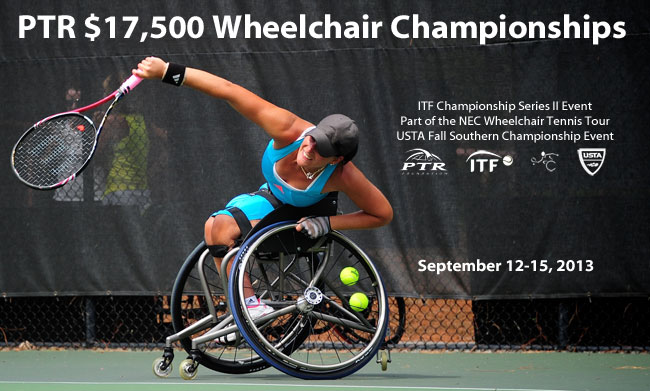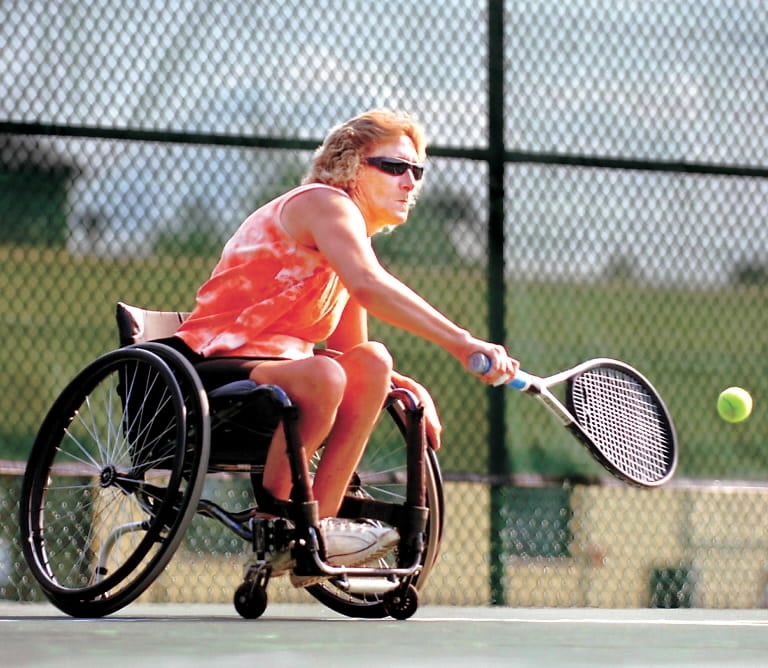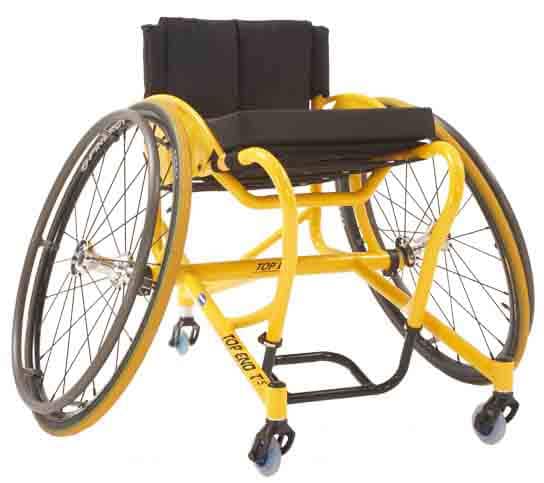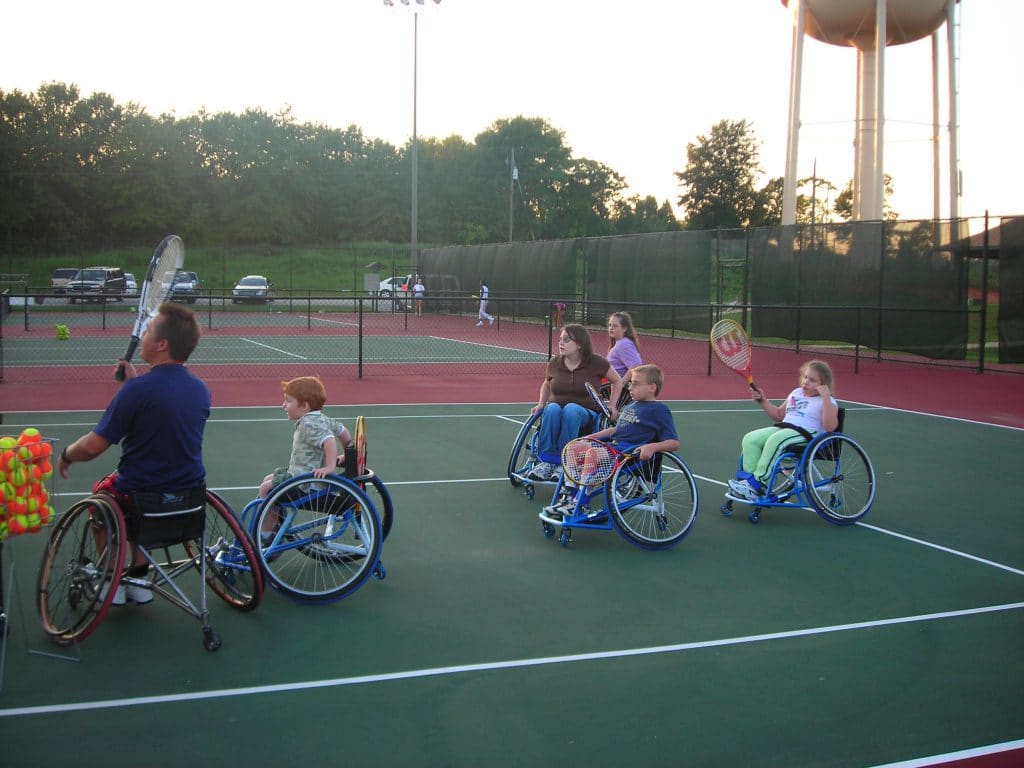
Editor’s Note: Tennis is one of the most popular wheelchair sports. As you progress, you can have plenty of competition with able-bodied tennis players as well as with wheelchair athletes. What has caused wheelchair tennis to have such phenomenal growth in the last few years? One major contributor to this growth has been the Professional Tennis Registry (PTR) and Tennis University, founded by Dennis Van Der Meer, a missionary kid from Namibia, Africa, whose mother taught him to play tennis at age 6 in about 1939, using a string tied to two sticks. Julie Jilly, vice president of marketing and special events for PTR, tells how Dennis Van Der Meer was able to grow the sport of tennis and become recognized both nationally and internationally as one of the best tennis teachers in the world.The Professional Tennis Registry (PTR) is the largest organization for professional tennis teachers and coaches in the world, with more than 14,000 members in 117 countries. We educate people about better methods of teaching and coaching tennis, and we certify teachers and coaches. Then, we service these people in an effort to grow the game of tennis and make tennis accessible to all people. We provide our members with information on how to teach children, how to teach adults and how to teach wheelchair tennis players. We teach them how to teach the different strokes that players will need to make in a tennis match. We send them information on how to coach more-advanced players, and we send them information on nutrition for tennis players.
The PTR was the brain child of Dennis Van Der Meer, who had established a tennis academy in Hilton Head, South Carolina. Although Dennis was a top player in Africa, his coach suggested he teach, and that’s what Dennis turned to in his early 20’s and said that was the best decision he ever made. Dennis recognized the value of tennis not only as a sport, but also as physical therapy. Not long after Dennis came to South Carolina, he went to the vocational-rehabilitation center’s office in Buford County and he explained, “If you have some wheelchair patients to rehab, I believe tennis would be a good therapy.” The people at the rehab office looked at Dennis and asked, “Are you insane? Disabled people can’t go out on a tennis court in a wheelchair.” To which Dennis replied, “Oh, yes they can.” Dennis believed and still does today that everyone can play tennis, and that statement is true.

Dennis believed that if tennis helped an able-bodied person in so many different ways, it also would provide the same advantages for people in a wheelchair. Today there’s a multitude of wheelchair sports, but 25-years ago there were very-few sports programs for people in wheelchairs. Dennis convinced the vocational-rehabilitation center to bring some of their patients in their everyday wheelchairs to his tennis facility. Although people playing tennis in their everyday chairs was difficult, Dennis quickly realized that they could play. The first group that came out started by swinging at balls, moving their wheelchairs, having a lot of fun and getting some exercise and sunshine. After three or four visits, the therapists at the vocational-rehabilitation center recognized the benefits of tennis. But they were even more convinced when the patients began to ask, “When can we go back and play tennis again?”
After several months, PTR created its first wheelchair tournament with only six players in 1985. Our players were older gentlemen, but those six players kept returning back year after year. They brought other people in wheelchairs to see what they had learned and how tennis was possible for individuals in wheelchairs. Over the next few years, our wheelchair tournament began to grow. After about 10 years, we had about 30 people attending our wheelchair tournament each year, and it was probably one of the biggest wheelchair tournaments in the nation at that time. In those early days, Dennis wanted to prove to his staff and to the occupational-therapy staff that tennis could be played anywhere - not only outside, but in a gym, a lunchroom or anywhere that had enough space to set-up a net. Dennis showed them how to use a wire coat hanger to make a round shape and use a pair of pantyhose over that round coat hanger to make a miniature racquet or paddle. Back then, the people at the rehab center didn’t have tennis racquets, and the players were using regular tennis balls. Today tennis balls based on nerf balls are specifically made for indoor tennis.

Now let’s regress just a little. Remember that Dennis Van Der Meer’s original goal was to make tennis available to everyone around the world. When he discovered how-much benefit the wheelchair tennis players were getting from the sport, he decided that the only way to grow wheelchair tennis around the world was to provide a curriculum and teach courses on how to teach and coach wheelchair tennis players. About 10 years after PTR had its first six-man wheelchair tennis tournament, Dennis developed the curriculum and the teaching methods and initially trained tennis instructors how to teach wheelchair tennis all across the nation.
One of the first problems Dennis encountered was that most tennis coaches weren’t interested in teaching tennis to people in wheelchairs. Too, most coaches and teachers didn’t believe there were very-many people in their communities in wheelchairs, because in those days, not-many people were out and about in wheelchairs. The coaches reasoned something like, “Since we’ve never seen a person in a wheelchair come out to the tennis courts, there must not be any of them in our community.” Dennis developed a relationship with the Memorial University Medical Center in Savannah, Georgia’s physical-therapy department. In the early spring, these therapists started bringing their wheelchair patients over to Dennis’s tennis center regularly. Dennis taught the patients how to play tennis and taught the physical therapists how to teach tennis to their patients. Gradually the sport of wheelchair tennis spread through physical therapy and rehab hospitals.
Next Dennis discovered that he really needed to teach the tennis pros at tennis facilities how to teach wheelchair tennis. Then, if an individual came to them in a wheelchair and asked to learn how to play tennis, they would be prepared to teach them. The PTR developed a 30-page manual, “Instructing Wheelchair Tennis,” that was distributed free of charge to all the tennis pros and tennis teachers around the world who were members of the PTR. The PTR also developed a course on how to teach wheelchair tennis. We found that very-few tennis instructors would come to the course and learn how to teach wheelchair tennis, again because they didn’t recognize the number of wheelchair people in their community. To solve this problem, PTR formed a foundation that gave scholarships to come to the course on teaching wheelchair tennis to instructors.

Since Dennis had traveled all over the world playing and teaching tennis, when he started the PTR, he realized that there were many countries that didn’t have enough money to send an instructor to the United States to learn how to teach tennis. He started the nonprofit foundation to bring instructors from around the world to learn to teach tennis and then return to their countries and teach tennis. His goal was to teach one individual in a country how to teach tennis and then ask that instructor to teach others. This charitable arm of PTR also helped provide the teachers with tennis equipment to use in their areas. Dennis realized large groups of children could be taught to play tennis if they had an instructor and equipment. Then 12-years ago, the PTR started a Special Olympics program for people with neurological problems.
Dennis felt there were two keys to growing tennis around the world – providing an instructor who could teach tennis and providing the equipment needed for the instructor to start teaching tennis wherever he or she lived. Dennis knew that at some point these instructors would be able to earn money teaching tennis. As they became better tennis instructors and earned money, more people in their communities would come to them for opportunities to start their own tennis-teaching programs. Dennis and his mother, who had brought some rackets and tennis balls with her to the mission field, had played tennis barefoot and on dirt spaces that weren’t even tennis courts, but when Dennis became a professional tennis player he realized what playing and teaching tennis had done for him and his family, personally and economically. He wanted to help other individuals be able to have an income from teaching tennis like he had received.
Dennis Van Der Meer Helps to Change the Image of Individuals in Wheelchairs
Today, the PTR has more-than 400 wheelchair-tennis players and 25 tennis coaches who coach from their wheelchairs. These 25 coaches not only coach wheelchair athletes, but they also teach and coach able-bodied players as well. Too, there are more-than-1,000 able-bodied tennis teachers worldwide who teach the sport of tennis to individuals in wheelchairs. These coaches not only have the knowledge and the ability to teach wheelchair tennis players but all have at least one or more wheelchair tennis players they’re actively coaching and teaching. Most rehab facilities are now using some form of tennis in their rehab programs. Dennis Van Der Meer started working with rehab hospitals at the very beginning of the PTR program. There are about 1,500 facilities using tennis as a part of their rehab programs across the United States today. Even if most of these facilities don’t have tennis courts, they can use foam tennis balls. If they don’t have nets, they can stretch some type of tape or ribbon between two chairs to function as a net.
Dennis wasn’t the founder of wheelchair tennis. I understand that some pioneers like Brad Parks, Randy Snow and others actually started the sport of wheelchair tennis to use tennis to enable the wheelchair community to have a sport in which they could compete. This idea of competitive wheelchair tennis was a much-different concept than what Dennis Van Der Meer was trying to do. The PTR does have competitions, but Dennis’ goal was to teach wheelchair tennis to enable the wheelchair community to enjoy the sport and to encourage physical therapists to use tennis as a rehabilitation exercise. Dennis saw tennis as a recreational and therapeutic sport for individuals in wheelchairs. Dennis recognized the gap that existed at that time- that there weren’t very-many instructors to teach tennis to individuals in wheelchairs. Solving the problem of the lack of instructors became his mission.
Today the PTR has five or six wheelchair tennis players who have become tennis coaches at their local high schools, and high school coaches are extremely important in the lives of tennis players. Many of our high-school teachers and coaches remain very important to all of us, even today. As mentors, they often have a tremendous amount of influence on the lives of the youngsters they teach and coach, and they’ve been able to prove to their students and the parents of those students that being in a wheelchair is not a disability. Many people have learned to look at these wheelchair coaches and not see what they can’t do, but rather what they can do.
For instance Johnny Johnston is a high-school coach in South Carolina. Every student in that school knows him. Each member of the faculty knows him, and most of the parents know him. They no longer see him as, “that man in the wheelchair.” He’s the tennis coach. He coaches able-bodied students, as well as wheelchair players. What we believe our program has done for our coaches in wheelchairs, as well as other people in wheelchairs, is to help communities see that the coach is a coach - he’s not a “wheelchair person,” - that people in wheelchairs aren’t different from everyone else. We believe wheelchair tennis helps remove barriers for individuals in wheelchairs, especially when some of our better wheelchair players can compete and win against able-bodied players. Wheelchair tennis has made tennis available to them, and we believe that this sport has helped tear-down barriers and overcome stereotyping.

What the PTR Can Do for You
Another benefit of tennis for both wheelchair players and able-bodied players is that it reaches across the age barrier. In the first wheelchair-tennis tournament the PTR ever held, our first team was made-up of older men in wheelchairs. Right now, our senior program is one of the fastest-growing programs in tennis. People are playing tennis much later in life now than they ever have before, because tennis is more accessible everywhere. The new equipment that’s being developed, like foam balls for indoor tennis, enables senior players to continue to play. Some of these seniors someday may be in a wheelchair at some time in their lives, and tennis is a sport they can continue to play, even if that day does come.
Too, sports chairs have been designed specifically for tennis. Tennis players have to reach up to throw their balls in the air and hit them with their racquets. When they lean back, there’s a possibility they may tip over. So, there’s a tip bar - on the backs of these chairs - a bar with a tiny wheel on the back of the chair that prevents the player from tipping over. They can reach back with their racquets for overhead shots, reach up for their serves and still not tip over. Instead of the wheels on the wheelchair being straight down, they are turned at an angle and cambered, to allow for more stability and give the players the ability to turn quickly safely. The wheels turn in at a 30-degree angle toward each other. The wheelchairs also have become much lighter. Many of our players go about their daily routines in their daily chairs, but when the time arrives to play tennis, they transfer to their sports chairs. Our wheelchair players have to carry two chairs with them. To make the sports chair more compact and lightweight, the sports chair’s wheels pop off, something that can be accomplished with one hand. So, our players can take the wheels off their sports chairs, put the wheels in their vehicle, pick up the light frame of the chair, load it into their vehicle and go to tennis tournaments. The chairs are designed to allow the players to disassemble, load their sports chairs and assemble them by themselves and play tennis unassisted.

If you want to try the sport of tennis, one of the advantages that you have is that you don’t have to find another person in a wheelchair with whom to play tennis. You can play at the United States Tennis Association (USTA) league in your town, at any club and any tennis facility. The rules are exactly the same. The only difference is that wheelchair athletes are allowed to let their balls bounce twice before they hit them instead of once. With this slight rule change, a wheelchair player can play tennis against anyone and enjoy tennis just like everyone else. Wheelchair players can call their local USTA office (1-914-696-7000) that should have a list of people who teach wheelchair tennis in the area, and the USTA has a portion of its website devoted to wheelchair tennis, where you can get more information on how to get started playing this game. Or, you can call the PTR at our international headquarters (1-800-421-6289), and we’ll help you locate one of our instructors in your area.
How To Become A Certified Wheelchair Tennis Instructor
To become a tennis coach and/or learn how to teach wheelchair tennis, go to ptrtennis.org. To become a certified wheelchair-tennis instructor through PTR, you first have to become a certified tennis instructor. Then you learn how to specialize in wheelchair tennis. An easier way to accomplish this is to come to one of our 5-hour courses that’s specifically instruction for teaching wheelchair tennis. You’ll receive a certificate to teach wheelchair tennis, but you won’t be a certified tennis instructor. You can learn more about how to receive certificates and instruction for teaching wheelchair tennis on the PTR Tennis website or calling our offices at 1-800-421-6289. On our website, you’ll see we’ve had 11 able-bodied tennis pros come to our facility to learn to teach wheelchair tennis. To teach them, we had them sit in wheelchairs. We wanted these pros who are currently teaching tennis all over the country to better understand what being a person in a wheelchair is like. Trying to learn tennis by this procedure gives them better insight about how to teach and coach the wheelchair person. The stories of how we’ve taught them to teach wheelchair tennis are on our website.
Another interesting story is that of a young man who was born without any legs whose parents owned a tennis facility. He’d hobble around and try to play tennis on the ends of his legs, but he had gotten to the point that his legs hurt too much to be able to play anymore. He wanted to play so bad that he started to damage the small portion of the legs that he had. So, he had to be put in wheelchair. His parents brought him to our tournament this year. They showed him all the people at our tournament who were playing wheelchair tennis. We had two 13-year-old players and two 15-year-old players. He learned that these young people not only played tennis and had fun doing it, but also had friends who played with them. This young man, who borrowed one of our sports chairs, learned he really could enjoy tennis from a wheelchair and not risk further damage to his body.

We gave another 13-year-old youngster a grant to come to the tournament. This tournament was his second to attend, but the first time he ever had played wheelchair tennis with individuals of all ages – 13 to 70 – from other parts of the country and the world. He was overwhelmed with the new friends he made, and the new opportunities he had. He was really motivated by seeing other people with the same challenges he had and what they were able to do on the tennis court. This is one of the reasons we continue to hold the tournaments each year. We can see that people who come to the tournaments can have their lives changed, whether they compete or just observe. They can see that tennis can help make them happier and healthier, and give them a healthier outlook on life. They often see that they can have a better quality of life simply by participating in the sport of tennis.
Dennis Van Der Meer - the Teacher of Teachers
Dennis Van Der Meer, the teacher of teachers, was in the right place at the right time. One of the most-famous historical tennis matches ever played was when Billie Jean King played Bobby Riggs, a noted tennis hustler, in a battle of the sexes. This tennis game was more than a tennis match and was set-up to prove or disprove that female tennis players were just as good and as competitive as their male counterparts. Bobby Riggs, besides being a tennis pro, was an extremely-good promoter, much like the great boxer Mohammed Ali – very vocal, very boisterous and with the ability to grab the attention of the worldwide media. When he challenged Billie Jean King to a tennis match titled the Battle of the Sexes, he knew that this tennis match would be promoted and televised around the world. Billie Jean King was put on the defensive and realized she had to defend her reputation against this world-class tennis player and coach. She also knew she was playing tennis for all the women of the world, to demonstrate that women could play tennis as well as the men and help elevate their position in the sport of tennis and the fight for equality. This one tennis match would be for women’s sports what Jesse Owens’ victories in the Olympic games of 1936 were for black athletes.
As publicity about the Battle of the Sexes tennis match ran rampant around the world, Billie Jean King, one of the most-successful women tennis players of her time, sought out Dennis Van Der Meer, the teacher of tennis teachers, to be her coach for this all-important worldwide event. He also coached Margaret Court, another of the sport’s most-successful female athletes. In the summers, Dennis went to Lake Tahoe to teach in Billie Jean King and Margaret Court’s summer camp, Tennis America. After Billie Jean King defeated Bobby Riggs, her popularity and the popularity of her coach Dennis Van Der Meer grew worldwide.
Here are reasons to play tennis from Jack Groppel, Ph.D.
According to world-renowned scientists from a variety of disciplines, there’s no doubt that tennis can improve your overall health, including your mental and physical fitness and is a sport that lasts a lifetime.
 Physical Reasons to Play Tennis
Physical Reasons to Play Tennis
Tennis enhances your:
1. aerobic fitness by burning fat and improving your cardiovascular fitness and maintaining higher energy levels.
2. anaerobic fitness by offering short, intense bursts of activity during a point followed by rest, which helps muscles use oxygen efficiently.
3. ability to accelerate by providing practice in sprinting, jumping and lunging quickly.
4. powerful first step by requiring anticipation, quick reaction time and explosion into action.
5. speed through a series of side-to-side and up and back sprints to chase the ball.
6. leg strength through hundreds of starts and stops that build stronger leg muscles.
7. general body coordination since you have to move into position and then adjust your upper body to hit the ball successfully.
8. gross motor control through movement and ball-striking skills that require control of your large muscle groups.
9. fine motor control by use of touch shots like angled volleys, drop shots and lobs.
10. agility by forcing you to change direction as many as five times in 10 seconds during a typical point.
11. dynamic balance through hundreds of starts, stops, changes of direction and hitting on the run.
12. cross-training through a physically-demanding sport that’s fun for athletes who specialize in other sports.
13. bone strength and density by strengthening bones of young players and helping prevent osteoporosis in older ones.
14. immune system through its conditioning effects, which promote overall health, fitness and resistance to disease.
15. nutritional habits by eating appropriately before competition to enhance energy production and after competition to practice proper recovery methods.
16. hand-eye coordination because you constantly judge the timing between the oncoming ball and the proper contact point.
17. flexibility due to the constant stretching and maneuvering to return the ball to your opponent.
Psychological Reasons to Play Tennis
Tennis helps you:
18. develop a work ethic, because improvement through lessons or practice reinforces the value of hard work.
19. develop discipline since you learn to work on your skills in practice and control the pace of play in competition.
20. manage mistakes by learning to play within your abilities, and realizing that managing and minimizing mistakes in tennis or life is critical.
21. learn to compete one-on-one, because the ability to do battle on the court trains you in the ups and downs of a competitive world.
22. accept responsibility by practicing skills and checking your equipment before a match, and by making accurate line calls during a match.
23. manage adversity by learning to adjust to the elements (e.g. wind, sun) and still be able to compete tenaciously.
24. control stress effectively, because the physical, mental and emotional stress of tennis will force you to increase your capacity for dealing with stress.
25. learn how to recover by adapting to the stress of a point and the recovery period between points, which is similar to the stress and recovery cycles in life.
26. plan and implement strategies, since you naturally learn how to anticipate your opponent’s moves and plan your countermoves.
27. learn to solve problems since tennis is a sport based on angles, geometry and physics.
28. develop performance rituals before serving or returning to control your rhythm of play and deal with pressure. These skills can transfer to taking exams, conducting a meeting or making an important sales presentation.
29. learn sportsmanship since tennis teaches you to compete fairly with opponents.
30. learn to win graciously and lose with honor. Gloating after a win or making excuses after a loss doesn’t work in tennis or in life.
31. learn teamwork, since successful doubles play depends on you and your partner’s ability to communicate and play as a cohesive unit.
32. develop social skills through interaction and communication before a match, while changing sides on the court and after play.
33. have fun - because the healthy feelings of enjoyment, competitiveness and physical challenge are inherent in the sport.
The World Will Be a Better Place if More People Play Tennis

Consider the wheat seed, small and insignificant when you hold it in your hand. If you drop it, you may not be able to find it, but when that wheat seed is planted in fertile ground, the seed grows and multiplies. Its offspring, when planted, continue to grow through many generations, until that one wheat seed has the potential of feeding a starving world. Young Dennis Van Der Meer, a missionary kid from Namibia, Africa, never could have dreamed that when his mother introduced him to the sport of tennis on a primitive dirt field that he would become a world changer. Dennis mainly competed in southern Africa, but soon learned that he preferred to teach tennis rather than be a competitive tennis player.
When Dennis was 19-years old, the Berkeley Tennis Club Foundation in Berkeley, California, sponsored Dennis to come to the United States to teach tennis. A friend of his named Jaroslav Houba from Czechoslovakia was already teaching at the club and recommended that the Berkeley Tennis Club bring Dennis to the United States as an instructor at their club. As word spread of Dennis’ teaching ability, more students came to him for instruction. However, he quickly realized that he wouldn’t be able teach all these people by himself. He realized that to grow his own business and the sport of tennis, he had to have additional teachers who could use his methods to teach others. So, during the summers, he set-up camps known as Tennis University to teach individuals how to teach tennis. Once again, because of his teaching ability, Dennis found himself with far-more students than he could teach. Students came from all over the world as word began to spread about the successful tennis-teaching methods he had developed. Before long, his travel schedule became so grueling that he knew that he couldn’t continue at that pace for long. So, he developed the idea of setting up a tennis-training center, where he and the instructors he had trained could teach tennis coaches from all over the world.
Tennis University consists of 10 days of instruction to better prepare individuals how to teach tennis and provides a step-by-step progression and method of teaching based on Dennis’ teaching strategies. One of the big advantages of the Tennis University system is that Dennis breaks tennis instruction down to its simplest form to enable tennis instructors to teach potential tennis players how to play better in a shorter time. Still, every year, Dennis traveled to Japan, South America and other countries, where he was invited to share his teaching methods for instructors. By teaching teachers how to teach tennis in different countries, the sport could grow more quickly and more people could be involved.
Then when Dennis had an opportunity to purchase a large piece of property in Hilton Head, South Carolina, he accepted the challenge of buying the property and building tennis courts and a pro shop. He built covered tennis courts, so that he and his instructors could teach, regardless of the weather. Once the property was purchased in 1980, Van der Meer made the decision to move his headquarters in Palo Alto, California, to Hilton Head, South Carolina. At that time, he had one facility with 18-tennis courts, and four of those courts were covered. Next, he built another facility with 18-tennis courts, including three indoor tennis courts. He also developed adult tennis camps and junior tennis camps. As more and more people came to his facility at Hilton Head, Dennis was able to reduce his extensive travel schedule.

According to Helma Cap, “Early in his career, Dennis hired my husband, Ludovit “Louie” Cap, who had a PhD in nuclear physics from Baylor University in Texas after they met one summer. After completing his PhD, Louie began to work for Dennis teaching tennis in 1974. In February, 2011, Dennis had a major stroke. Today, Pat Van Der Meer, Dennis’s wife, runs the business side of the PTR (Professional Tennis Registry), a tennis teacher organization for students who have completed the TennisUniversity or other courses and workshops the TennisUniversity offers. My husband Louie is now in charge of the instructional side of the TennisUniversity. The PTR is growing at a rate of about 1,200 members per year. Today, the PTR not only has an active teaching program that teaches instructors how to teach wheelchair tennis, they also have one of the world’s largest wheelchair tennis tournaments, where wheelchair athletes from around the world come to compete on many-different levels at the PTR facility.”
To learn more about the PTR, go to www.ptrtennis.org or call 800-421-6289 or 843-785-7244.